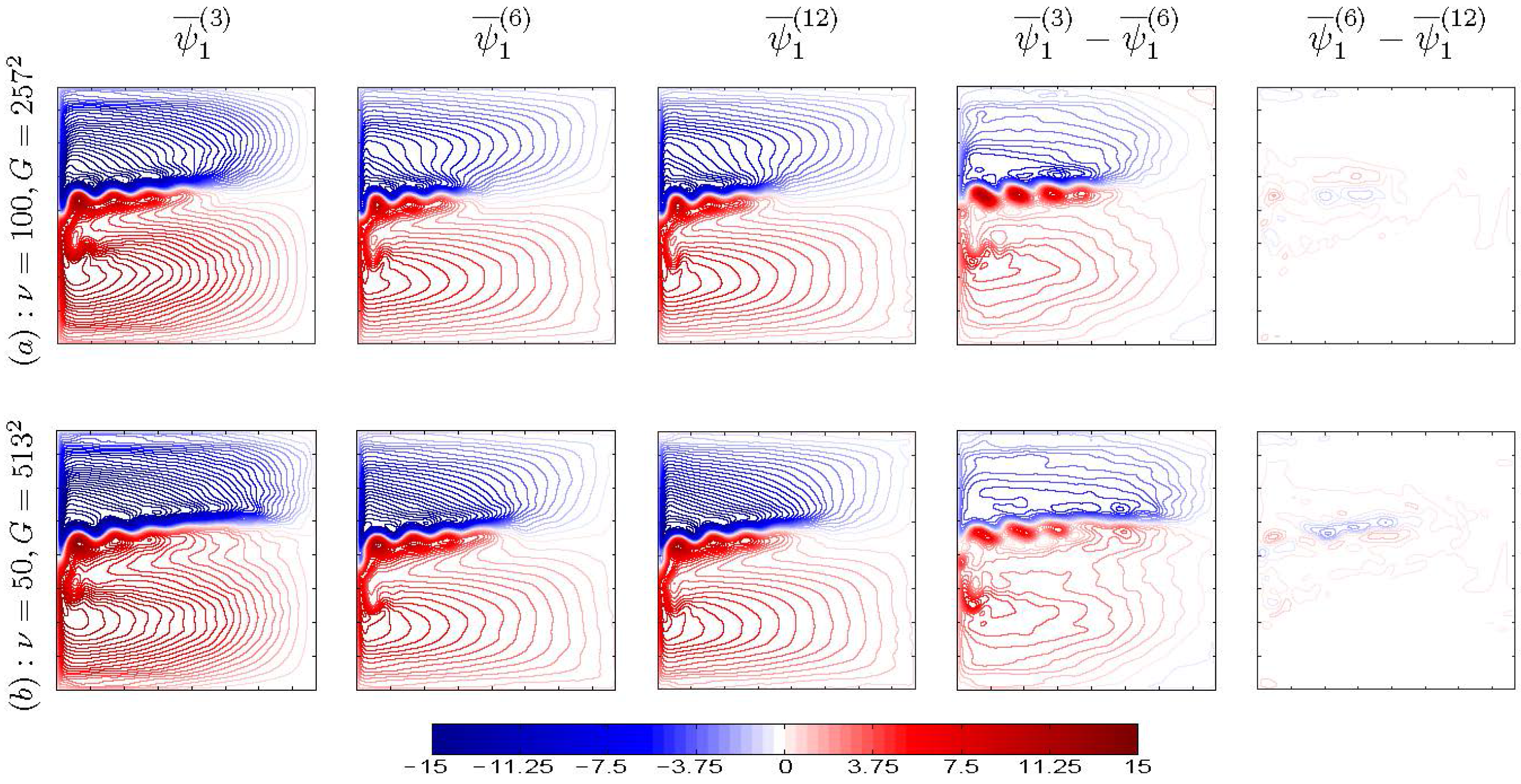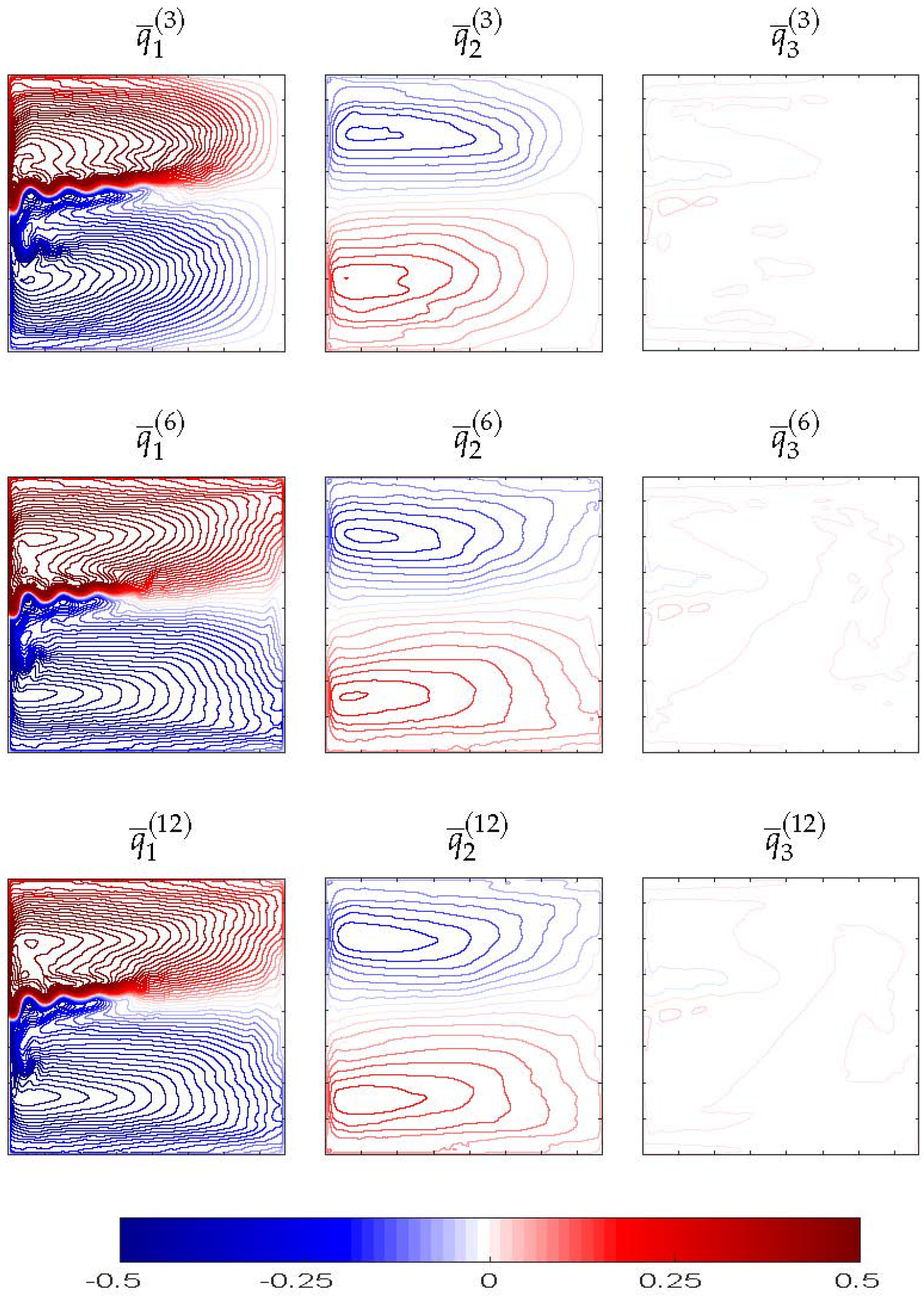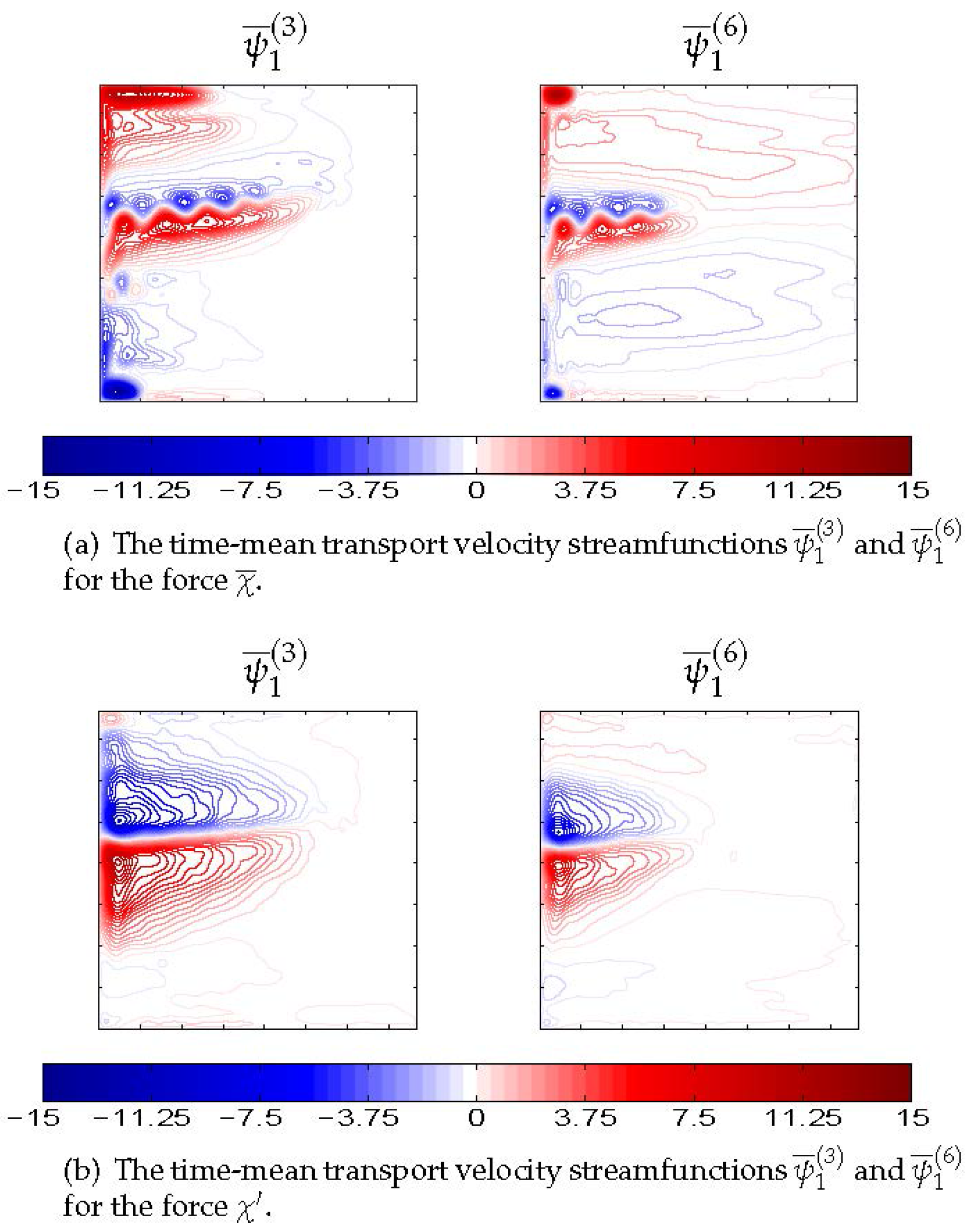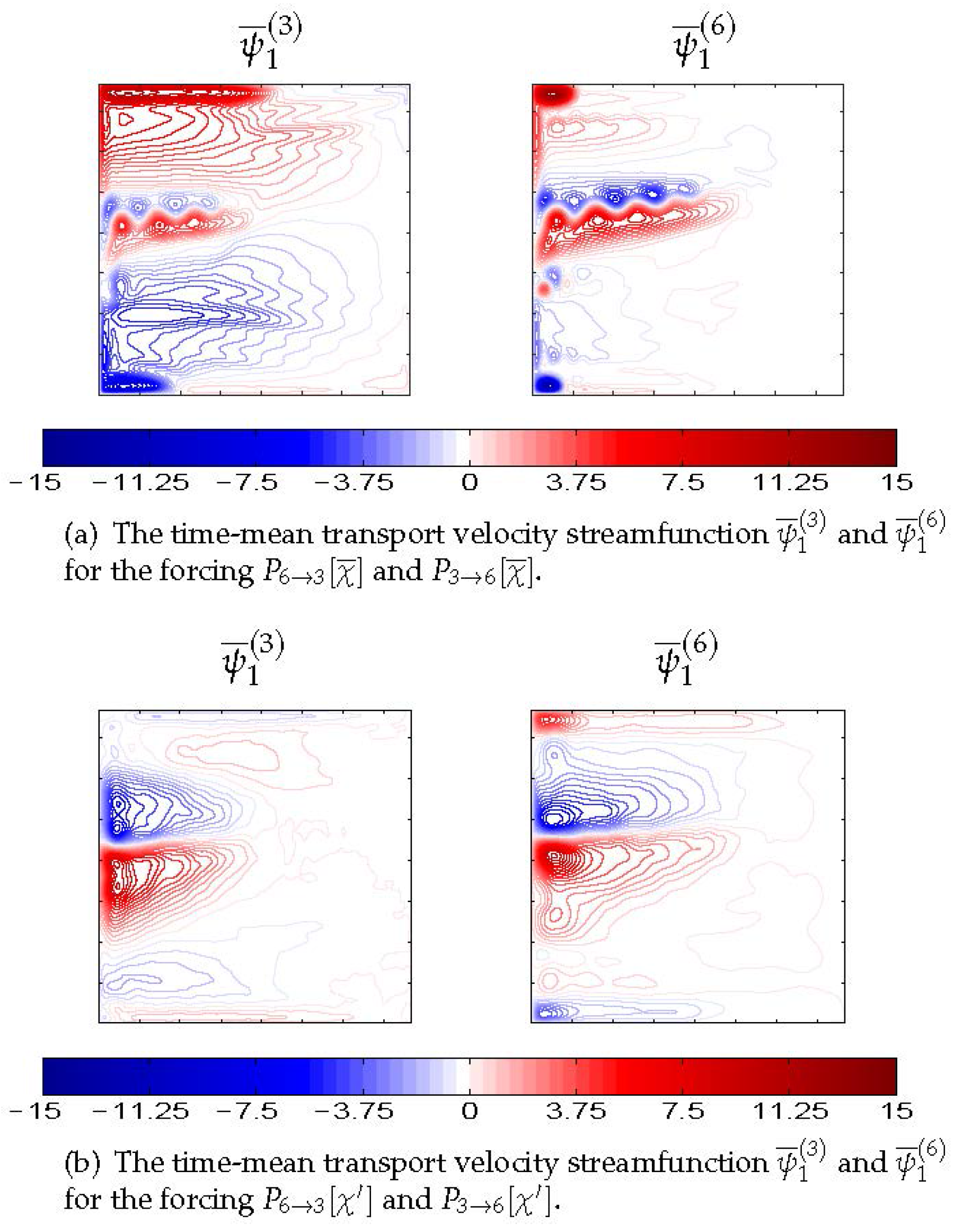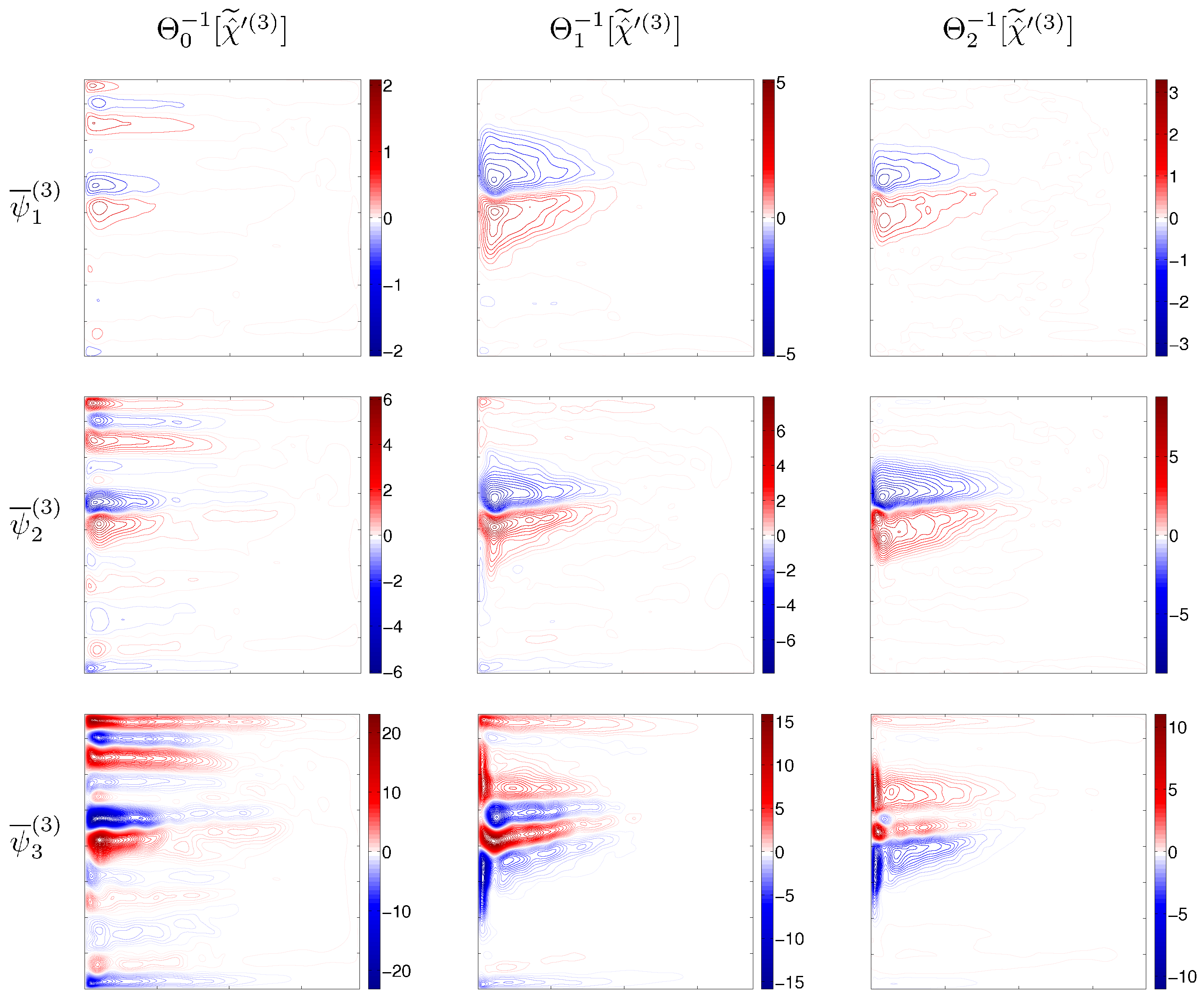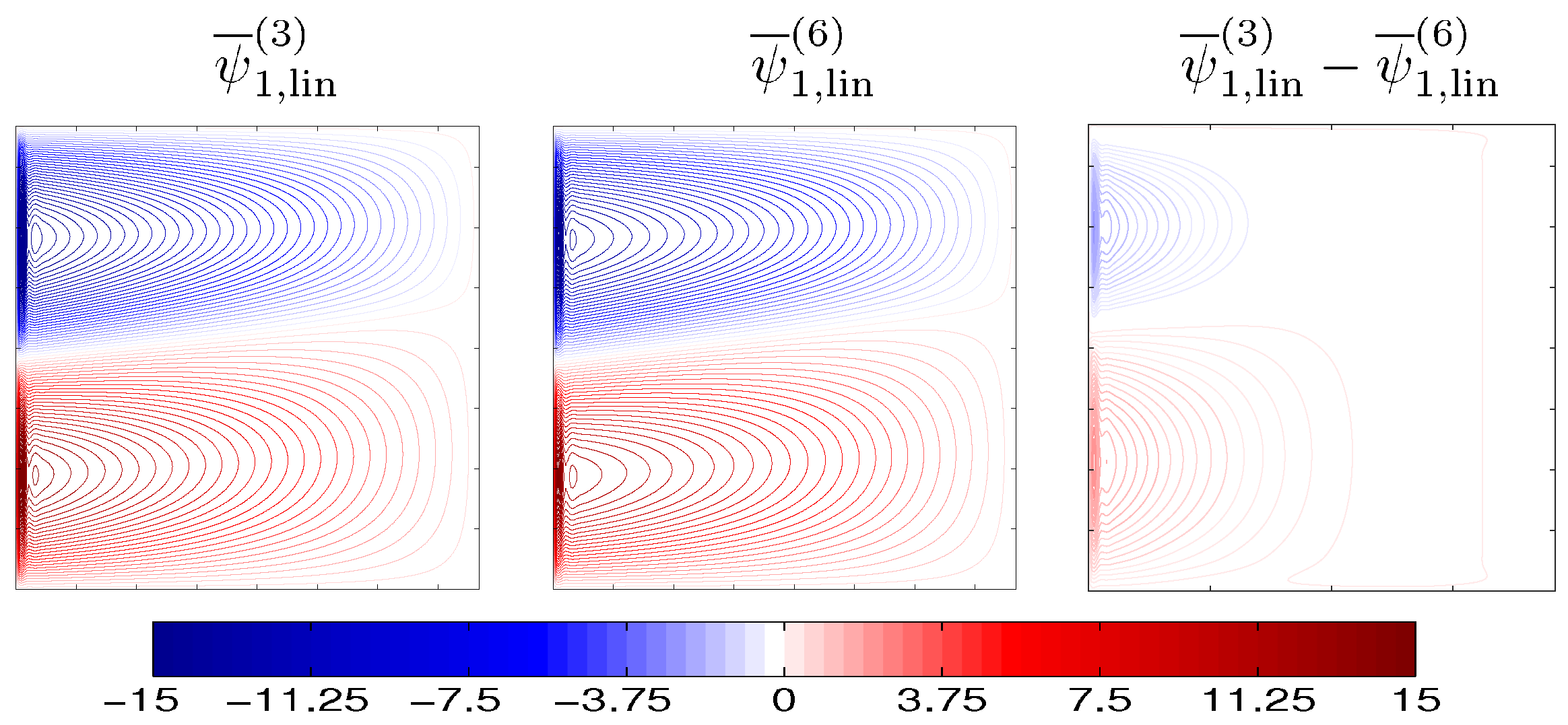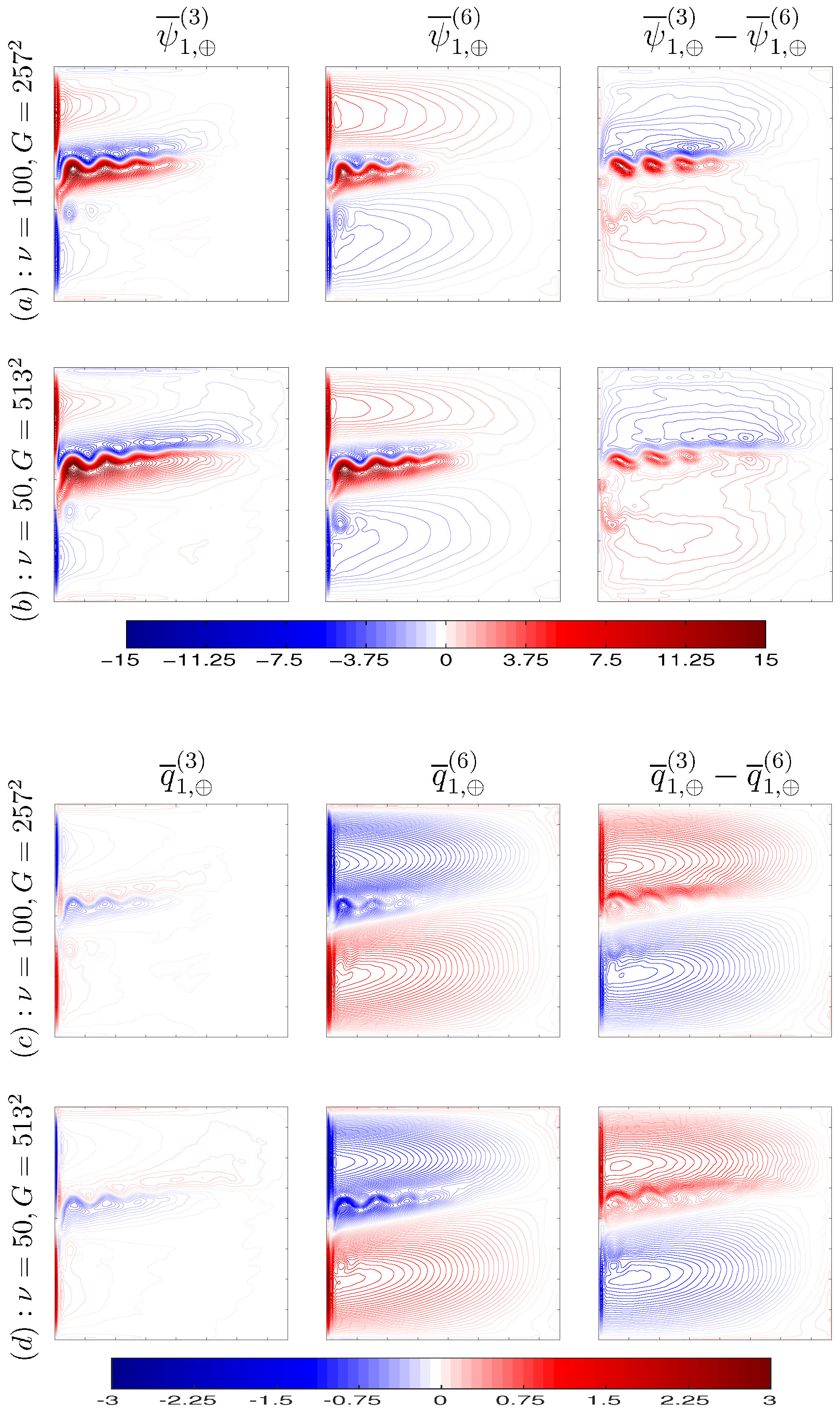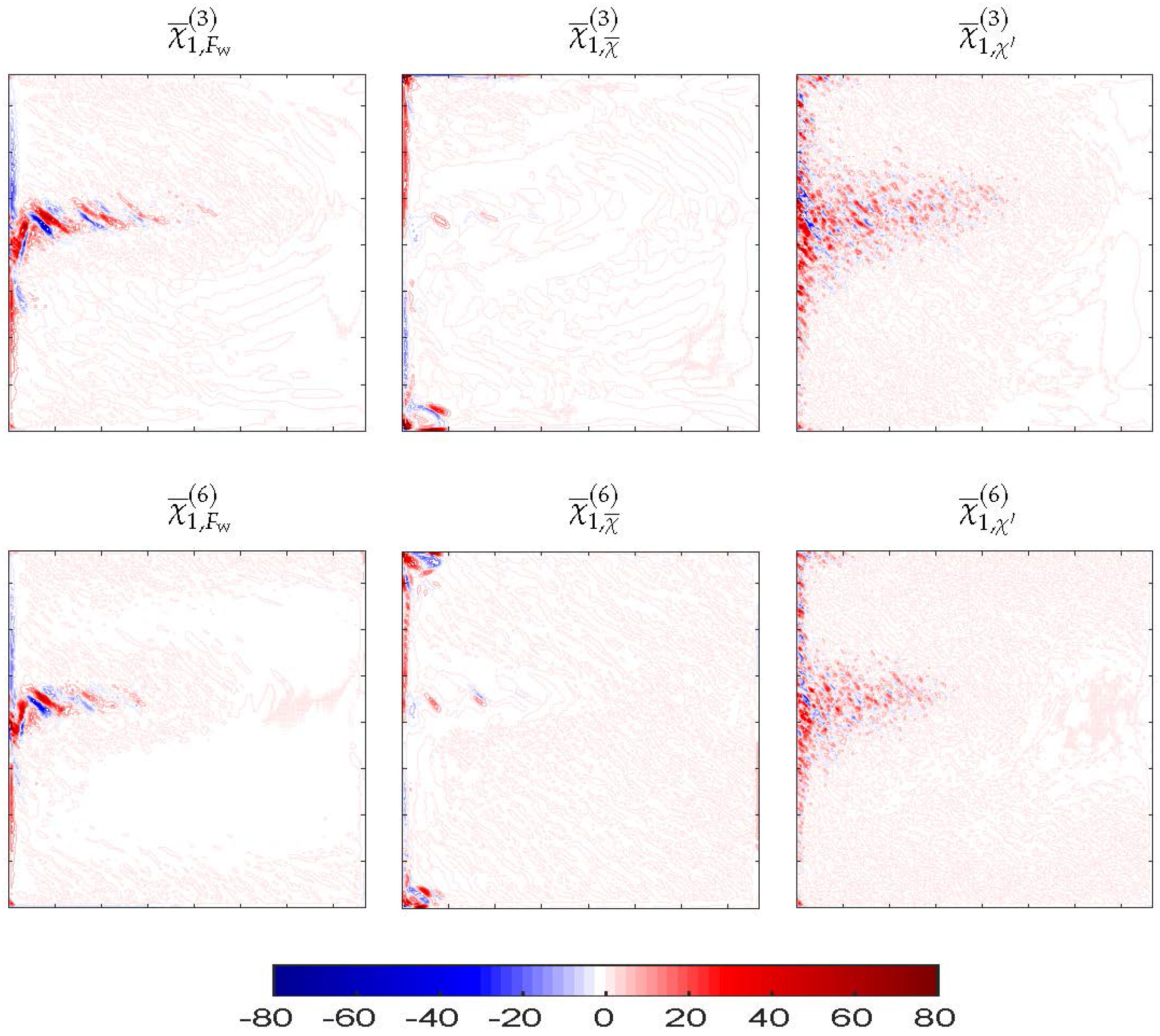Studying turbulent flow dynamics in process-oriented ocean models with decreasing eddy viscosity, that is with increasing reliance on the explicit eddy dynamics rather than its parameterization, helps to understand the physics and, thus, guide comprehensive general circulation modeling. First, we analyze how the eddy viscosity ν influences the penetration length of the eastward jet, (i.e., the distance from the western boundary to the eastern point of the time-mean jet at which the flow velocity drops below ), the volume transport , and the relative -norm difference δ between flow fields obtained with different horizontal and vertical resolutions.
Although, it is clear that differences between 3L and 6L solutions are due to the lack of vertical resolution, such an explanation misses the underlying physical mechanism. To address this issue we studied more thoroughly the solutions with , while leaving out (due to the lack of computational resources) similarly detailed analyses of the problem with .
3.1. Eddy Backscatter and Vertical Modes
In this section we study roles of the vertical modes in the main mechanism supporting the eastward jet—the eddy backscatter (see, e.g., [
20] in the QG context). We focus on the eddy PV flux divergence, denoted by
χ and referred to as the eddy forcing,
and analyse how it affects the large-scale flows.
We considered the time-mean
and transient
components of the eddy forcing [
21], and, in order to find their dynamical interpretations, carried out numerical experiments discussed further below. Note that
does not enter the dynamical time-mean balance directly. However, it does so indirectly by driving and controlling the eddy patterns which rectify into the mean flow; our analyses account for this mechanism rather than focus on the less informative time-mean balance. We also decomposed the flow solution into large- and small-scale components and found that the corresponding (and slightly different)
is systematically correlated with the large-scale eastward jet and enhances it—this is a statistical measure of the eddy backscatter. The simplest way to think about the involved eddy backscatter mechanism is by considering a spatially localized, time-periodic, zero-mean forcing and its dynamical effects [
22]: direct contribution of this forcing to the time-mean dynamical balance is zero, nevertheless, it may have an indirect leading-order dynamical effect via systematic correlations with the large-scale flow. It has been shown [
4] that at moderate Reynolds numbers this indirect effect provides the main mechanism supporting the eastward jet extension and its adjacent recirculation zones, and here we continue to explore this mechanism at larger Reynolds numbers, with finer horizontal and vertical grid resolutions, and in a more detailed way.
The first series of our numerical experiments (
Figure 3) studies dynamical responses to
and
imposed on the state of rest and, thus, provides dynamical interpretation of these eddy forcing patterns. The results show that the eastward jet is induced not only by the time-mean component
(
Figure 3a) but even more so by the transient component
(
Figure 3b). The latter maintains the eastward jet via positive correlations between the induced jet and
, similarly to what happens in the full double-gyre circulation. When the flow is forced by
, the eastward jet length and volume transport are larger in the 3L solution (e.g.,
and
); here the subscript indicates the force applied. A similar situation is with the volume transport of the flow forced by
, i.e.,
and
. Thus, we arrive at the important conclusion that the eastward jet and its adjacent recirculation zones are induced not only by the time-mean but more so by the transient eddy forcing, and the jet-maintaining effect weakens with higher vertical resolution.
In fact, the difference between 3L and 6L solutions may be explained by different structures and/or amplitudes of the eddy forcing components. To check this, we projected
and
onto the 6L model, and
and
onto the 3L model and found the corresponding dynamical responses. In order to do this, we introduced operator
, which transforms the i-layer forcing into the j-layer forcing consistently with configurations of the layer depths:
The responses of the models to
and
;
and
(
Figure 4) provide dynamical interpretations of the eddy forcings components in terms of the induced large-scale flow responses as functions of vertical resolution. The transformed forcings
,
and
,
induce similar to the reference solutions structure (
Figure 3 and
Figure 4). However, the resulting volume transports
and
are inhibited and reinforced compared to
and
, respectively, and more so for the fluctuating parts of the eddy forcing:
and
. Moreover,
for the solution induced by
or
, which is opposite to the
-forced case.
The similarity between the solutions forced by
,
and by
and
(as well as by
,
and by
and
) suggests that the 3L and 6L forces are structurally similar, and only their amplitudes are different. Here, we quantify the amplitude difference in terms of the integrals of the standard deviation of
(
Table 4 and
Figure 5). In order to verify the amplitude hypothesis we factored out this difference, normalized the amplitudes of the projected quantities
,
and computed new forcing fields:
The results are given in
Figure 6. The responses of the 3L and 6L models to the forcings
and
are nearly the same (
Figure 3b and
Figure 6): the volume transports
and
; the relative errors are
and
; and the eastward jet lengths are
and
for the solutions induced by the forcing
and
, respectively. Thus, we conclude that the key aspect is the difference between the amplitudes of the fluctuating components of the 3L and 6L eddy forcings. The mechanism setting the amplitude of the eddy forcing can be understood in terms of vertical modes. For brevity, we refer to the vertical modes as modes and study efficiencies of their feedbacks.
In order to assess individual contributions of the vertical modes to the eddy backscatter, and, thus, to gain further understanding in dynamical effects of higher vertical resolution, we express the QG Equation (
1) in terms of the vertical modes
φ. For doing so, we rewrite the system of elliptic Equation (
2) in vector form as
where
S is the stratification matrix defined for
as
with the stratification parameters
,
.
Multiplying (
5) by some matrix Θ yields
The matrix Θ is chosen so that
, where Λ is the diagonal matrix of the eigenvalues of the stratification matrix
, and columns of
are the corresponding eigenvectors of
. Hence, Equation (
6) can be rewritten as
Thus, the QG Equation (
1) and velocity streamfunction can be projected from layers
onto modes
by the linear transformation
, where
denotes the barotropic mode, and
is the
m-th baroclinic mode. In fact, the mode
is the streamfunction representation of the
i-th mode. The inverse transformation
maps the modes back to the layers. We also introduce the selected-mode inverse transformation
, in which all the modes in the inverse mapping, but the
m-th one, are set to zero.
In order to study how efficient is eddy forcing of each mode, we define the efficiency of a forcing
(defined further below) applied to the QG model as a ratio between the volume transport of the corresponding flow
(forced with
) and the reference flow
(forced with the constant wind forcing
):
where
is the corresponding volume transport. In other words, the efficiency of forcing
determines the measure of strength of the eastward jet (forced with
) with respect to the jet forced with
.
We analyze the 3L and 6L model responses to the selected
m-mode forcings
(the fluctuating component of the eddy forcing
is firstly projected forward onto the modes and then backward onto the layers, with all the modes, save for the
m-th one, set to zero before the backward projection; then, the eddy forcing
projected onto the layers is used as a forcing in the right hand side of Equation (
1)), and found that in the 6L model the barotropic and first baroclinic modes are the most efficient ones (
Table 5). Our study also reveals two features common to both models: (a) the higher the mode of the eddy forcing is, the weaker its rectified response (
Figure 7 and
Figure 8); (b) the barotropic, first and second baroclinic eddy forcing modes are the most efficient ones. As shown in
Figure 7, the largest responses to the forcing
are concentrated in
and
modes, suggesting that they accommodate most of the backscatter, although the resulting amplification of the eastward jet is dominated by
. In the 6L case,
plays similar role, but
has weaker feedback (
Figure 8). Overall, we conclude that the 3L model captures the quantitative dynamics of the eastward jet but significantly overestimates its strength. Finally, we confirm that all 3L/6L differences are due to the nonlinear eddy effects, because the corresponding linear solutions are nearly the same (
Section 3.2).
The eddy backscatter is not the only mechanism taking part in the nonlinear dynamics of the eastward jet. In the next section, we study another important mechanism which works against the backscatter (i.e., inhibits the eastward jet).
3.2. Counter-Rotating Gyre Anomalies
Before passing on to the discussion of the results, it is helpful to decompose the flow into the linear part (i.e., linear-dynamics time-mean response) the time-mean eddy-induced nonlinear anomalies, denoted by the subscript “lin” and “⊕”, respectively, and the transient (primed) fluctuations:
In order to check how eddies affect the eastward jet length
we excluded the linear parts
(the numerical solution of the governing equations linearized around the state of rest and computed with the CABARET method) of the 3L and 6L models, which are essentially the same (
,
Figure 9), and focused on the analysis of the nonlinear eddy-induced anomalies
(the difference between the fully nonlinear eddy-induced solution
and its linear part
), for which
δ is much larger, i.e.,
(
Figure 10a). We found that the difference between the nonlinear components of the 3L and 6L solutions is basin-wide, but with the maximum concentrated mostly around the eastward jet (
Figure 10a). To check that this behavior persists with increasing nonlinearity, we carried out another series of experiments with lower
and obtained similar difference
, also mostly localized around the eastward jet (
Figure 10b).
As can be seen in
Figure 10, the eddy-induced anomalies are characterized by the opposite-sign PV anomalies embedded in the gyres and slowing them down. We call these flow features “Counter-rotating Gyre Anomalies” (CGAs). The CGAs and their roles in ocean dynamics have never been recognized and analysed in the past, probably, because these flow features are masked by the powerful gyres, hence, they are studied here for the first time. Since CGAs weaken the gyres, which constitute the main pool of energy available to the eddies, it is reasonable to assume that they also inhibit the eddy-driven eastward jet. Can suppression of the CGAs strengthen the gyres and, by feeding more energetic eddies, elongate the eastward jet and enhance its adjacent recirculation zones? This hypothesis, motivated by the fact that weaker gyres (e.g., due to weaker wind forcing) tend to support weaker eastward jet, can be verified by switching the CGAs off with an extra compensating forcing that needs to be found.
Substitution of (
8) into (
1) and the subsequent time averaging lead to the time-mean balance
with
.
On the other hand, the linearization of (
1) and its time averaging yield
which being substituted into (
9) gives
By analyzing the terms in (
11) we found that the CGAs are induced by
(i.e., by the term
), which is balanced (in the neighborhood of the CGAs) by the term
(the advection of planetary vorticity by the time-mean eddy-induced flow anomaly). The other terms in (
11) have negligible effects on the CGAs. Thus, if
is added to the right hand side of (
1), it should induce the circulation anomalies in the direction opposite to the CGAs. Full dynamical interpretation of this advection term, as well as explanation of the nonlinear mechanism responsible for it, is beyond the scope of this paper. Enhancing the CGAs weakens the eastward jet in both 3L and 6L solutions (
Figure 11a,b), that is consistent with our hypothesis. When we suppress the CGAs, the eastward jet strengthens only in 3L case, but remains nearly the same in the 6L solution (
Figure 12).
In the presence of higher baroclinic modes (6L case) the CGAs become wider and stronger and this happens along with the weakening of the eastward jet. Explaining this CGAs amplification is beyond the scope of this paper, but we hypothesize that the weaker 6L eastward jet implies a weaker barrier to cross-gyre PV transport by material particles [
23]. Hence, more opposite-sign PV penetrates into each gyre from the other gyre. This mechanism can be interpreted as “cooling” of the gyre, and its direct verification requires analysis of PV on Lagrangian trajectories.
Summarizing the results, we found that inhibits the eastward jet by creating zonally elongated anticyclonic/cyclonic CGAs in the subpolar/subtropical gyre. However, this effect is moderate, and the jet is still more actively maintained by the eddy backscatter mechanism.
It is useful to compare how the time-mean eddy forcing
depends on different forcings used in our study (
Figure 13). In the solution driven by the constant wind forcing
,
is strong and mostly concentrated in the eastward jet and its recirculation zones, while in case of the solution forced with the time-mean component of eddy-forcing,
is located along the western boundary. In the latter case, the eddy forcing is weak, since it is significantly inhibited by the CGAs (
Figure 3a). On the contrary, the 3L solution forced with
shows a
stronger
, which populates smaller scales. However, in the 6L case,
is
weaker (
Figure 3) thus indicating that the CGAs are strong in both
and
. Thus one can explain the elongation or shortening of the eastward jet by the competition between the CGAs and eddy backscatter: if the CGAs overcome the eddy backscatter then the jet shortens, if the eddy backscatter is stronger than the CGAs then the jet elongates.
